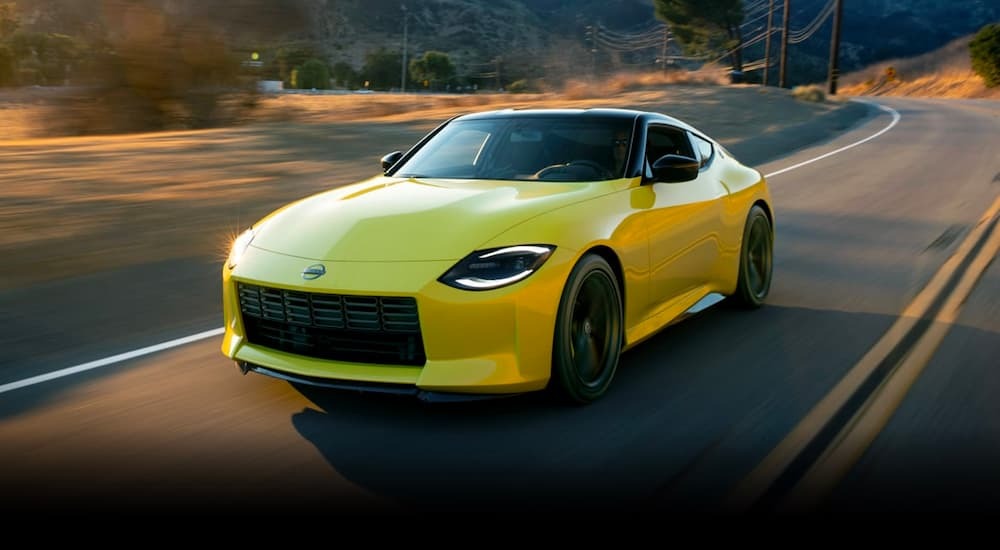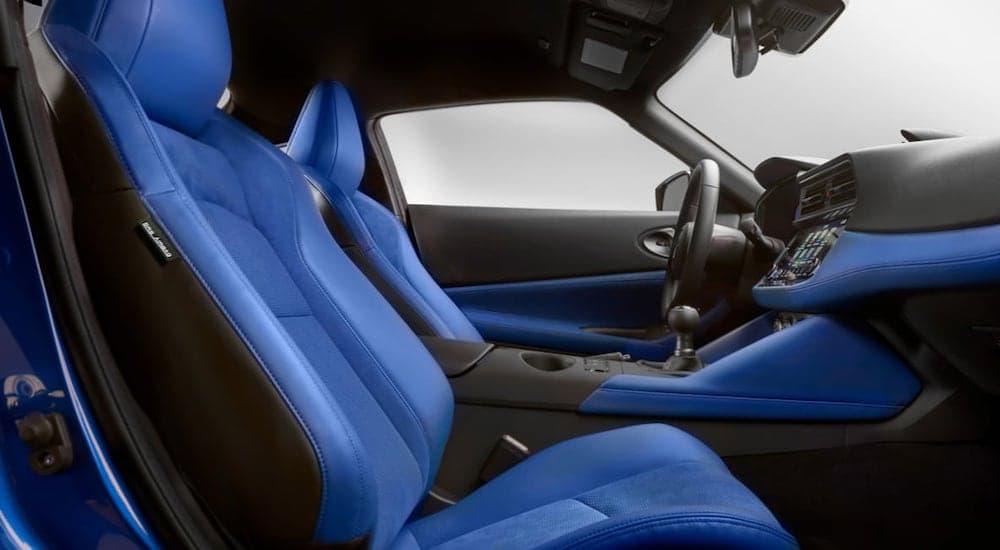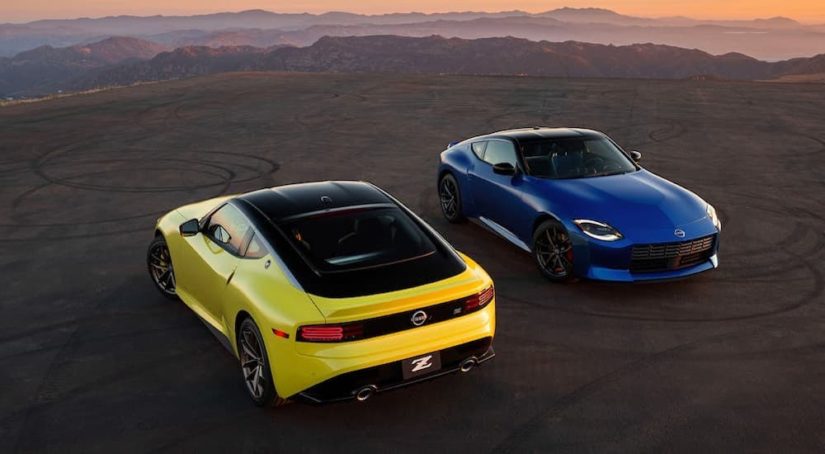The highly-anticipated 2023 Nissan Z is set to go into production soon, and Z car enthusiasts are chomping at the bit for a definitive date for its arrival on Nissan dealer lots. Rumblings on the internet suggest leaks from Nissan indicate June as a possible time for deliveries to begin, but that’s hearsay until confirmation from Nissan comes to pass. For the moment, anyone excited about the next generation of the Z car can read on and geek out about the new design. It’s about time, too, since the 370Z held onto its relatively unchanged frame for 11 years. So, how will the new 2023 Z improve upon the 370Z, and what features will make the new Z a good buy? Let’s start with comparing the old to the new.
2020 370Z vs 2023 Z
Looking at the two cars side by side, the new 2023 model of the Z car isn’t a revolutionary change in appearance. It’s a mild shift in design cues that indicates a newer car, like the sculpted bodywork in the hood and sides and the lower height of the back end that recalls the original 240Z, which inspired the 2023 design. The outgoing 370Z is all about smooth edges, while the new Z adds slight raised edges like a pointed shape in the hood bulge and a straight ridge high along the sides. In the front fascia of the 370Z, the grille is less pronounced than the very angular shape of the 2023 Z grille, and the headlights of the 370Z with their signature notched shape are changed in favor of a new almond shape, reminiscent of the 240Z’s headlight reflection shadow.
One thing that hasn’t changed is the chassis. Though Nissan has revealed the 2023 Z as a fully redesigned vehicle, the underlying chassis is based on the 370Z, so driving dynamics are likely to be familiar. However, there will be a lot more horsepower from a new 3.0-liter twin-turbo V6, with up to 400 hp and 350 lb-ft of torque promised. That’s a respectable upgrade compared to the 332 hp of the 3.7-liter V6 found in the 2020 models. On the interior, the 2023 Z has a welcome amount of standard technology that was missing in all but the most expensive models from the past, including an eight-inch infotainment screen loaded with Apple CarPlay and Android Auto. What remains are the three analog instrument gauges in the dash above the center stack, which now show boost, turbo speed, and voltage.

Those three gauges in the 2020 model had a clock, the oil temperature, and voltage, with only the last one remaining unchanged. Boost is probably familiar to enthusiasts as the indicator of pressure within the intake manifold, which affects how much power is available for acceleration. In close relationship to boost is the turbo speed gauge, and it’s an uncommon gauge to find in a car, even in serious sports cars. Having the turbo speed gauge show the driver how fast the turbocharger is revolving is valuable information about utilizing it more effectively if you read the gauge to see when it’s peaking. In comparison to the new inclusion of boost and turbo speed, it seems odd to have kept the voltage gauge when another option related to performance might have been a better choice.
Here is yet another point of comparison in terms of performance between the 370Z and the 2023 Z: the engine. For the 370 Z, the engine was naturally aspirated. Now, the 2023 Z is arriving with a twin-turbocharged powertrain which we already mentioned is upping the horsepower significantly. Dedicated enthusiasts may bemoan the loss of natural aspiration with concerns about turbo lag, but the amount of power the Z will command is nothing to sneeze at. Even if turbo lag is noticeable to an attentive driver, it should balance out the performance when the increased torque takes over to accelerate faster.
Welcome New Features
Thankfully, the long nose and short back end are still the prominent overall design of the 2023 Z, which is as it should be. The changes arise in some rather exciting new technology features, yet the interior doesn’t overwhelm with too much modern style. In the cockpit, the driver will find that Nissan keeps the layout of the former 370Z, so all the displays, buttons, and most of the important hardware like the emergency brake and shift knob will all feel familiar. The most noticeable difference is in the 12.3-inch digital driver display, which has an attractive full-color screen that animates when the vehicle is started and sharp, easy-to-read graphics. Drivers can customize the display, which also is where drive modes are viewed and selected from the steering wheel controls.
Nissan is offering the 2023 Z in two trims, and the standard features are a far cry from what was included in the 2020 models. The Intelligent Key with push-button start, rearview camera, and Intelligent Cruise Control are welcome equipment upgrades for the base Sport trim, and the Performance trim upgrades to a larger 9-inch touchscreen with navigation and NissanConnect, which includes WiFi. Audiophiles will appreciate the sound quality of the Bose audio system that somehow fits eight speakers into the cabin built for two, a feature found in the Performance models. One nice extra for the upper trim is the available blue suede and leather upholstery that electrifies the lower half of the cabin while the upper portion of the interior remains dark and sporty.
Now that driver-assist technology is becoming the standard for the automotive industry, Nissan finally caved and brought a suite of safety features to the Z for 2023. Previous model years had no such inclusion, so this is new to Z car enthusiasts. All the usual equipment like Automatic Emergency Braking with Pedestrian Detection and Lane Departure Warning will be included, plus Nissan’s higher-grade Intelligent Forward Collision Warning can scout two cars ahead to spot any imminent danger so it can be avoided. Fortunately, the 2023 Z still comes with a manual six-speed transmission so drivers can enjoy the thrill of working the clutch, though a nine-speed automatic with paddle shifters is available.

A Special Edition For the New Generation
A limited run of special editions for 2023 will be available, but the numbers are small. This edition is called the Proto Spec, and it will come clad in yellow, with matching yellow brake calipers, contrasting stitching in the cabin, and yellow accents on the edge of the sport seats and door trim. In addition, bronze 19-inch RAYS wheels will adorn the exterior, wearing the same Bridgestone Potenza performance tires as the Performance models. The limited run of the Proto Spec will mean only 240 cars will be built, which means serious enthusiasts interested in one of these rare cars had better not doze while waiting for news about ordering one.
Nissan has made it clear that this new design for 2023 is created by enthusiasts for enthusiasts. As one of the most affordable performance cars on the market, the Z car definitely has a lot of attributes to inspire drivers from all walks of life. The tidy packaging of the low-slung Z car begs to be driven and admired. When dropping into the driver’s seat, even before hitting the ignition, the Z cradles the body encouragingly against the grip of suede and body-hugging bolstering. Placing your hands on the steering wheel feels utterly natural, and you’ll get the sense there’s no better place to be than in control of a car eager to meet the pavement and bring you along for the ride.



